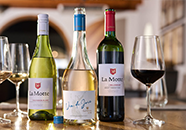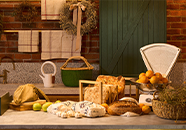Pierneef as stylis / stylist
Aanvanklik het Pierneef, soos sy leermeesters, Anton van Wouw en Frans Oerder, in die idioom van die romantiese realisme gewerk. Tog het hy vroeg reeds besef dat hy, in sy soeke na ’n eie Suid-Afrikaanse kunsstyl, van dié styl afstand sou moes doen.
In 1917 het Pierneef in ’n uitstalling saam met Fanie Eloff werk ten toon gestel wat deur die Duitse impressionistiese beweging beïnvloed is. Hy het die stippelmetode van verfaanwending gebruik en, wat styl betref, was die werk ook nader aan die kubisme. In dié tyd was daar boonop sterk invloede van die San-rotskuns in sy werk aanwesig.
In Julie 1919 het Pierneef besluit om hom voltyds op sy kuns toe te spits. Hy het hom al hoe meer in die San-rotskuns en die sierkuns van swart mense instudeer. Tegnies is hy sterk beïnvloed deur veral die San se gebruik van vereenvoudigde en kragtige, skoon lyne. Van die simbole wat swart mense gebruik het, het later ook in sy skilderkuns tot uiting gekom. Hier kan ’n mens dus praat van ’n geneigdheid tot primitivisme, wat in daardie tyd in Europa verken is.
In 1925-26 het Pierneef in Europa met verskillende nuwe kunsbewegings kennis gemaak. Self het hy in die styl van Art Nouveau belang gestel. Hy het ook die impressionisme en die Neo-Impressionisme leer ken, en is aan Futurisme, wat ’n beperkte invloed op sy stylontwikkeling gehad het, blootgestel. Abstraksie, Kubisme en Simbolisme het vir hom ’n besonderse aantrekkingskrag gehad, en word veral in sy werk in die tydperk 1925 tot 1935 geopenbaar. Sy sterker stylinvloede was van die Simbolisme, wat oor die gedagte van monumentale kuns gehandel het, in die besonder die werk en filosofie van die Hollandse kunstenaar, Willem van Konijnenburg. Met simbolisme moes die vorme van die werklikheid gestileer word om aan die idee van monumentaliteit uiting te gee.
Daarbenewens was Pierneef bewus van die Franse landskapskilders van sy eie generasie, wat geometriese strukture aangewend het om vorm voor te stel. Hulle het gepoog om die “onsienlike” weer te gee. ’n Tema wat Pierneef herhaaldelik verken het, was die omgewing van Rustenburgkloof, waar hy geometriese vorms verder tot ’n gebalanseerde en dekoratiewe geheel kon uitbou.
In Pierneef se werk gedurende sy lang en produktiewe loopbaan is daar eggo’s van internasionale kunsstrominge te bespeur. Tog het dit hom uiteindelik tot ’n persoonlike vertolking van die Suid-Afrikaanse landskap gelei, wat juis die grondslag van ’n eie Suid-Afrikaanse kunsstyl sou vorm.
In imitation of his mentors, Anton van Wouw and Frans Oerder, Pierneef initially worked in the idiom of romantic realism. Yet, he soon realised that he would have to part with this style in search of a uniquely South African style of art.
In 1917, Pierneef joined Fanie Eloff in an exhibition where he displayed work containing distinct influences of the German impressionistic movement. He employed pointillism in his paint application and, in terms of style, his work also verged on cubism. At this stage, one could also identify strong influences of San rock art in his work.
In July 1919, Pierneef decided to pursue art as a full-time career. He immersed himself in San rock art and the decorative arts of black people. In terms of technique, Pierneef was strongly influenced by, particularly, the San’s use of simplified and powerful, clean lines. Some of the symbols used by black people could also be traced in his later paintings. Here one could, therefore, speak of an inclination towards primitivism, which was being explored in Europe at the time.
During 1925 to 1926, Pierneef got to know various new art movements in Europe. He personally showed a particular interest in the Art Nouveau style. He also learned about Impressionism and Neo-Impressionism, and was exposed to Futurism, which influenced his style development to a limited extent. He found Abstraction, Cubism and Symbolism especially interesting, which manifested in his work in the period 1925 to 1935. His stronger stylistic influences came from Symbolism, which flirted with the idea of monumental art, in particular the work and philosophy of Dutch artist Willem van Konijnenburg. With Symbolism, the forms of reality had to be stylised to give expression to the idea of monumentality.
In addition, Pierneef was aware of the French landscape artists of his own generation, who used geometric structures to represent form. They attempted to portray the “invisible” in their work. A recurring theme that Pierneef explored is the area of Rustenburg Kloof, where he could further expand on geometric shapes to achieve a balanced and decorative whole.
During his long and prolific career, one does detect echoes of international art streams in Pierneef’s work. However, these ultimately led him to a personal interpretation of the South African landscape, which went on to serve as the very foundation of a uniquely South African style of art.
Teks / Text: Amanda Botha
















